Use of E-Waste in Metakaolin Blended Cement Concrete for Sustainable Construction
Abstract
1. Introduction
2. Materials and Methods
2.1. Recovery of Non-Metallic Powder from e-Waste
2.2. Materials
2.3. Mix Design
2.4. Mechanical Performance
2.5. Durability Performance
2.5.1. Water Absorption
2.5.2. Rapid Chloride Penetration Test (RCPT)
2.5.3. Sorptivity
2.6. Analytical Techniques
2.6.1. X-ray Diffraction (XRD)
2.6.2. Scanning Electron Microscopy with EDS
3. Results and Discussion
3.1. Characterization of Raw Materials
3.2. Mechanical Performance
3.2.1. Compressive Strength
3.2.2. Splitting Tensile Strength
3.2.3. Flexural Strength
3.3. Durability Performance
3.3.1. Water Absorption
3.3.2. Sorptivity
3.3.3. Rapid Chloride Penetration (RCPT) Test
3.4. Analytical Studies
3.4.1. X-ray Diffraction (XRD)
3.4.2. Microstructure and Morphological Studies
4. Conclusions
Author Contributions
Funding
Institutional Review Board Statement
Informed Consent Statement
Data Availability Statement
Acknowledgments
Conflicts of Interest
References
- Naqi, A.; Jang, J.G. Recent Progress in Green Cement Technology Utilizing Low-Carbon Emission Fuels and Raw Materials: A Review. Sustainability 2019, 11, 537. [Google Scholar] [CrossRef]
- Sakulich, A.R. Reinforced geopolymer composites for enhanced material greenness and durability. Sustain. Cities Soc. 2011, 1, 195–210. [Google Scholar] [CrossRef]
- Wang, T.; Nicolas, R.S.; Kashani, A.; Ngo, T. Sustainable utilisation of low-grade and contaminated waste glass fines as a partial sand replacement in structural concrete. Case Stud. Constr. Mater. 2022, 16, e00794. [Google Scholar] [CrossRef]
- Sundaralingam, K.; Peiris, A.; Anburuvel, A.; Sathiparan, N. Quarry dust as river sand replacement in cement masonry blocks: Effect on mechanical and durability characteristics. Materialia 2022, 21, 101324. [Google Scholar] [CrossRef]
- Steyn, Z.; Babafemi, A.; Fataar, H.; Combrinck, R. Concrete containing waste recycled glass, plastic and rubber as sand replacement. Constr. Build. Mater. 2020, 269, 121242. [Google Scholar] [CrossRef]
- International E-Waste Day: 57.4M Tonnes Expected in 2021 | WEEE Forum. Available online: https://weee-forum.org/ws_news/international-e-waste-day-2021/ (accessed on 16 October 2022).
- Sejal Mehta Electronic Waste: The Need to Reuse, Repair, Recycle and Safely Dispose. Available online: https://india.mongabay.com/2020/08/explainer-the-why-and-how-of-disposing-electronic-waste/ (accessed on 11 May 2022).
- Kaliyavaradhan, S.K.; Prem, P.R.; Ambily, P.; Mo, K.H. Effective utilization of e-waste plastics and glasses in construction products-a review and future research directions. Resour. Conserv. Recycl. 2022, 176, 105936. [Google Scholar] [CrossRef]
- Debnath, B.; Chowdhury, R.; Ghosh, S.K. Sustainability of metal recovery from E-waste. Front. Environ. Sci. Eng. 2018, 12, 1–12. [Google Scholar] [CrossRef]
- Kumar, K.S.; Gandhimathi, R.; Baskar, K. Assessment of Heavy Metals in Leachate of Concrete Made With E-Waste Plastic. Adv. Civ. Eng. Mater. 2016, 5, 256–262. [Google Scholar] [CrossRef]
- Zhou, Y.; Qiu, K. A new technology for recycling materials from waste printed circuit boards. J. Hazard. Mater. 2010, 175, 823–828. [Google Scholar] [CrossRef]
- Chen, M.; Huang, J.; Ogunseitan, O.A.; Zhu, N.; Wang, Y.-M. Comparative study on copper leaching from waste printed circuit boards by typical ionic liquid acids. Waste Manag. 2015, 41, 142–147. [Google Scholar] [CrossRef]
- Zhu, X.-N.; Nie, C.-C.; Wang, S.-S.; Xie, Y.; Zhang, H.; Lyu, X.-J.; Qiu, J.; Li, L. Cleaner approach to the recycling of metals in waste printed circuit boards by magnetic and gravity separation. J. Clean. Prod. 2020, 248, 119235. [Google Scholar] [CrossRef]
- Das, A.; Vidyadhar, A.; Mehrotra, S. A novel flowsheet for the recovery of metal values from waste printed circuit boards. Resour. Conserv. Recycl. 2009, 53, 464–469. [Google Scholar] [CrossRef]
- Zhang, Y.; Liu, S.; Xie, H.; Zeng, X.; Li, J. Current Status on Leaching Precious Metals from Waste Printed Circuit Boards. Procedia Environ. Sci. 2012, 16, 560–568. [Google Scholar] [CrossRef]
- He, J.; Duan, C. Recovery of metallic concentrations from waste printed circuit boards via reverse floatation. Waste Manag. 2017, 60, 618–628. [Google Scholar] [CrossRef]
- Iji, M. Recycling of epoxy resin compounds for moulding electronic components. J. Mater. Sci. 1998, 33, 45–53. [Google Scholar] [CrossRef]
- Guo, J.; Guo, J.; Wang, S.; Xu, Z. Asphalt Modified with Nonmetals Separated from Pulverized Waste Printed Circuit Boards. Environ. Sci. Technol. 2008, 43, 503–508. [Google Scholar] [CrossRef]
- Guo, J.; Rao, Q.; Xu, Z. Application of glass-nonmetals of waste printed circuit boards to produce phenolic moulding compound. J. Hazard. Mater. 2008, 153, 728–734. [Google Scholar] [CrossRef]
- Kumar, K.S.; Baskar, K. Recycling of E-plastic waste as a construction material in developing countries. J. Mater. Cycles Waste Manag. 2014, 17, 718–724. [Google Scholar] [CrossRef]
- Gao, Z.; Li, J.; Zhang, H.-C. Printed circuit board recycling: A state-of-the-art survey. IEEE Trans. Electron. Packag. Manuf. 2003, 27, 33–42. [Google Scholar] [CrossRef]
- Frías, M.; Cabrera, J. Pore size distribution and degree of hydration of metakaolin–cement pastes. Cem. Concr. Res. 2000, 30, 561–569. [Google Scholar] [CrossRef]
- Jaskulski, R.; Jóźwiak-Niedźwiedzka, D.; Yakymechko, Y. Calcined Clay as Supplementary Cementitious Material. Materials 2020, 13, 4734. [Google Scholar] [CrossRef] [PubMed]
- Medjigbodo, G.; Rozière, E.; Charrier, K.; Izoret, L.; Loukili, A. Hydration, shrinkage, and durability of ternary binders containing Portland cement, limestone filler and metakaolin. Constr. Build. Mater. 2018, 183, 114–126. [Google Scholar] [CrossRef]
- Wild, S.; Khatib, J. Portlandite consumption in metakaolin cement pastes and mortars. Cem. Concr. Res. 1997, 27, 137–146. [Google Scholar] [CrossRef]
- Homayoonmehr, R.; Ramezanianpour, A.A.; Mirdarsoltany, M. Influence of metakaolin on fresh properties, mechanical properties and corrosion resistance of concrete and its sustainability issues: A review. J. Build. Eng. 2021, 44, 103011. [Google Scholar] [CrossRef]
- Khatib, J.M.; Clay, R.M. Absorption characteristics of metakaolin concrete. Cem. Concr. Res. 2004, 34, 19–29. [Google Scholar] [CrossRef]
- Courard, L.; Darimont, A.; Schouterden, M.; Ferauche, F.; Willem, X.; Degeimbre, R. Durability of mortars modified with metakaolin. Cem. Concr. Res. 2003, 33, 1473–1479. [Google Scholar] [CrossRef]
- Poon, C.; Kou, S.; Lam, L. Compressive strength, chloride diffusivity and pore structure of high performance metakaolin and silica fume concrete. Constr. Build. Mater. 2006, 20, 858–865. [Google Scholar] [CrossRef]
- Kavitha, O.; Shanthi, V.; Arulraj, G.P.; Sivakumar, V. Microstructural studies on eco-friendly and durable Self-compacting concrete blended with metakaolin. Appl. Clay Sci. 2016, 124–125, 143–149. [Google Scholar] [CrossRef]
- Al-Akhras, N.M. Durability of metakaolin concrete to sulfate attack. Cem. Concr. Res. 2006, 36, 1727–1734. [Google Scholar] [CrossRef]
- IS 12269-13; Ordinary Portland Cement, 53 Grade—Specification. Bureau of Indian Standards: Delhi, India, 2013; Volume 1, pp. 3–12.
- IS 383 (2002); Specification for Coarse and Fine Aggregates from Natural Sources for Concrete. Bureau of Indian Standards: Delhi, India, 1970; Volume 383.
- ASTM C618-03; Standard Specification for Coal Fly Ash and Raw or Calcined Natural Pozzolan for Use. ASTM International: West Conshohocken, PA, USA, 2010; pp. 3–6.
- IS 9103; Specification for Concrete Admixtures. Bureau of Indian Standards: Delhi, India, 1999; pp. 1–22.
- IS 10262; Guidelines for Concrete Mix Design Proportioning. Bureau of Indian Standards: New Delhi, India, 2009; pp. 1–14.
- IS 516; Method of Tests for Strength of Concrete. Bureau of Indian Standards: Delhi, India, 1959; pp. 1–30.
- ASTM C642; Standard Test Method for Density, Absorption, and Voids in Hardened Concrete. ASTM International: West Conshohocken, PA, USA, 2013; pp. 1–3. [CrossRef]
- ASTM C1202; Standard Test Method for Electrical Indication of Concrete’s Ability to Resist Chloride Ion Penetration. American Society for Testing and Material: West Conshohocken, PA, USA, 2012; pp. 1–8. [CrossRef]
- ASTM C1585-13; Standard Test Method for Measurement of Rate of Absorption of Water by Hydraulic Cement Concretes. ASTM International: West Conshohocken, PA, USA, 2013; Volume 41, pp. 1–6. [CrossRef]
- Deschner, F.; Winnefeld, F.; Lothenbach, B.; Seufert, S.; Schwesig, P.; Dittrich, S.; Goetz-Neunhoeffer, F.; Neubauer, J. Hydration of Portland cement with high replacement by siliceous fly ash. Cem. Concr. Res. 2012, 42, 1389–1400. [Google Scholar] [CrossRef]
- Kakria, K.; Thirumalini, S.; Secco, M.; Priya, T.S. A novel approach for the development of sustainable hybridized geopolymer mortar from waste printed circuit boards. Resour. Conserv. Recycl. 2020, 163, 105066. [Google Scholar] [CrossRef]
- 12457-2, E. EN 12457-2:2002-Characterisation of Waste-Leaching-Compliance Test for Leaching of Granular. Available online: https://standards.iteh.ai/catalog/standards/cen/db6fbdf3-1de7-457c-a506-46c4898e3f09/en-12457-2-2002 (accessed on 25 April 2022).
- Li, M.; Zhu, X.; Mukherjee, A.; Huang, M.; Achal, V. Biomineralization in metakaolin modified cement mortar to improve its strength with lowered cement content. J. Hazard. Mater. 2017, 329, 178–184. [Google Scholar] [CrossRef]
- Ramli, M.B.; Alonge, O.R. Characterization of metakaolin and study on early age mechanical strength of hybrid cementitious composites. Constr. Build. Mater. 2016, 121, 599–611. [Google Scholar] [CrossRef]
- Mou, P.; Xiang, N.; Duan, G. Products made from nonmetallic materials reclaimed from waste printed circuit boards. Tsinghua Sci. Technol. 2007, 12, 276–283. [Google Scholar] [CrossRef]
- Parande, A.K.; Babu, B.R.; Karthik, M.A.; Kumaar, K.D.; Palaniswamy, N. Study on strength and corrosion performance for steel embedded in metakaolin blended concrete/mortar. Constr. Build. Mater. 2008, 22, 127–134. [Google Scholar] [CrossRef]
- Dinakar, P.; Sahoo, P.K.; Sriram, G. Effect of Metakaolin Content on the Properties of High Strength Concrete. Int. J. Concr. Struct. Mater. 2013, 7, 215–223. [Google Scholar] [CrossRef]
- Guo, J.; Cao, B.; Guo, J.; Xu, Z. A Plate Produced by Nonmetallic Materials of Pulverized Waste Printed Circuit Boards. Environ. Sci. Technol. 2008, 42, 5267–5271. [Google Scholar] [CrossRef]
- Kumar, K.S.; Baskar, K. Briefing: Shear strength of concrete with E-waste plastic. Proc. Inst. Civ. Eng. Constr. Mater. 2015, 168, 53–56. [Google Scholar] [CrossRef]
- Zheng, Y.; Shen, Z.; Cai, C.; Ma, S.; Xing, Y. Influence of nonmetals recycled from waste printed circuit boards on flexural properties and fracture behavior of polypropylene composites. Mater. Des. 2009, 4, 958–963. [Google Scholar] [CrossRef]
- CEB Bulletins: Diagnosis and Assessment of Concrete Structures (PDF). Available online: https://www.fib-international.org/publications/ceb-bulletins/diagnosis-and-assessment-of-concrete-structures-detail.html (accessed on 26 April 2022).
- Ilić, B.; Radonjanin, V.; Malešev, M.; Zdujić, M.; Mitrović, A. Study on the addition effect of metakaolin and mechanically activated kaolin on cement strength and microstructure under different curing conditions. Constr. Build. Mater. 2017, 133, 243–252. [Google Scholar] [CrossRef]
- Sabir, B.; Wild, S.; Bai, J. Metakaolin and calcined clays as pozzolans for concrete: A review. Cem. Concr. Compos. 2001, 23, 441–454. [Google Scholar] [CrossRef]
- Zhu, W.; Bartos, P.J. Permeation properties of self-compacting concrete. Cem. Concr. Res. 2003, 33, 921–926. [Google Scholar] [CrossRef]
- Marsh, B.; Day, R.; Bonner, D. Pore structure characteristics affecting the permeability of cement paste containing fly ash. Cem. Concr. Res. 1985, 15, 1027–1038. [Google Scholar] [CrossRef]
- Subaşı, A.; Emiroğlu, M. Effect of metakaolin substitution on physical, mechanical and hydration process of White Portland cement. Constr. Build. Mater. 2015, 95, 257–268. [Google Scholar] [CrossRef]







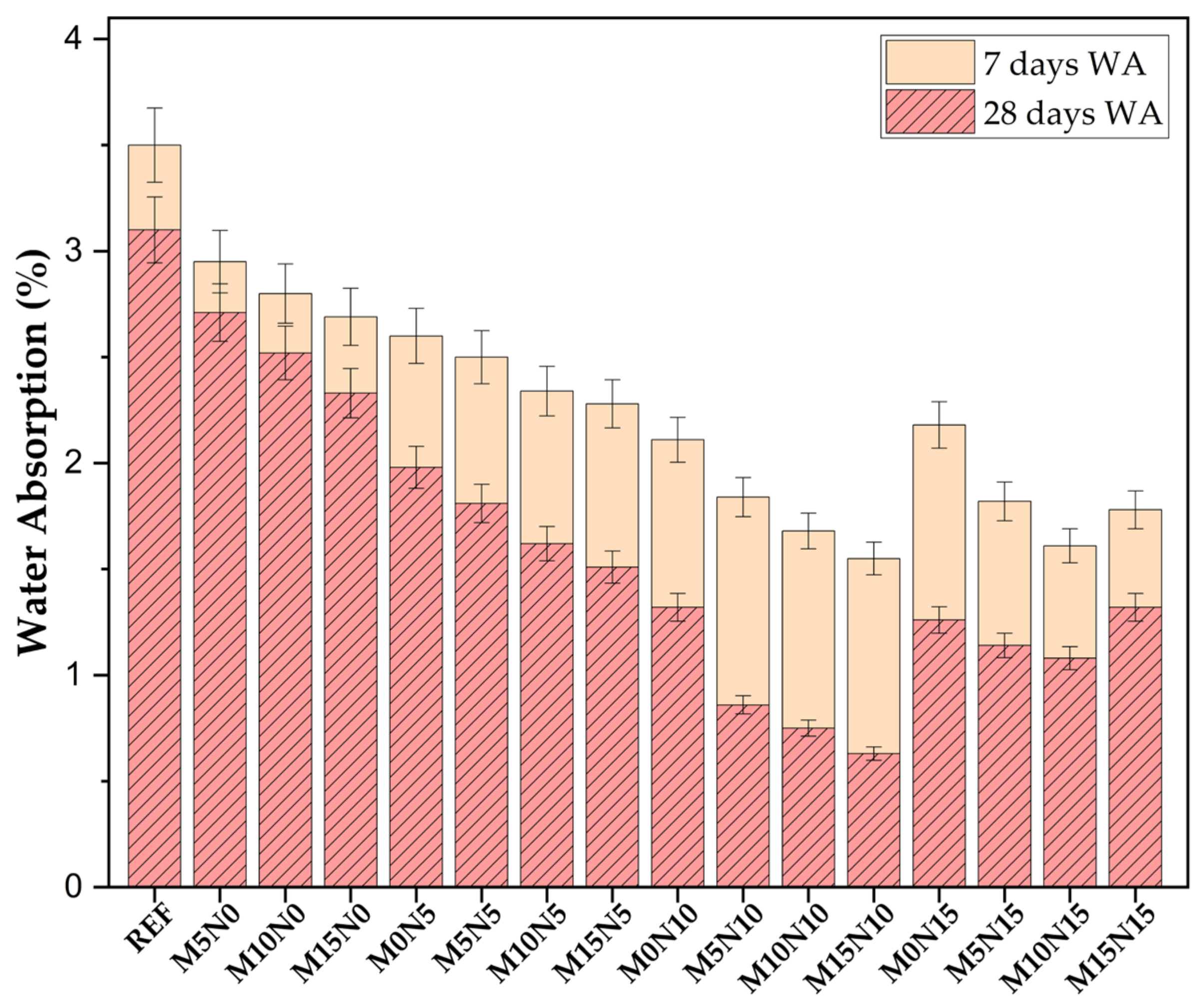
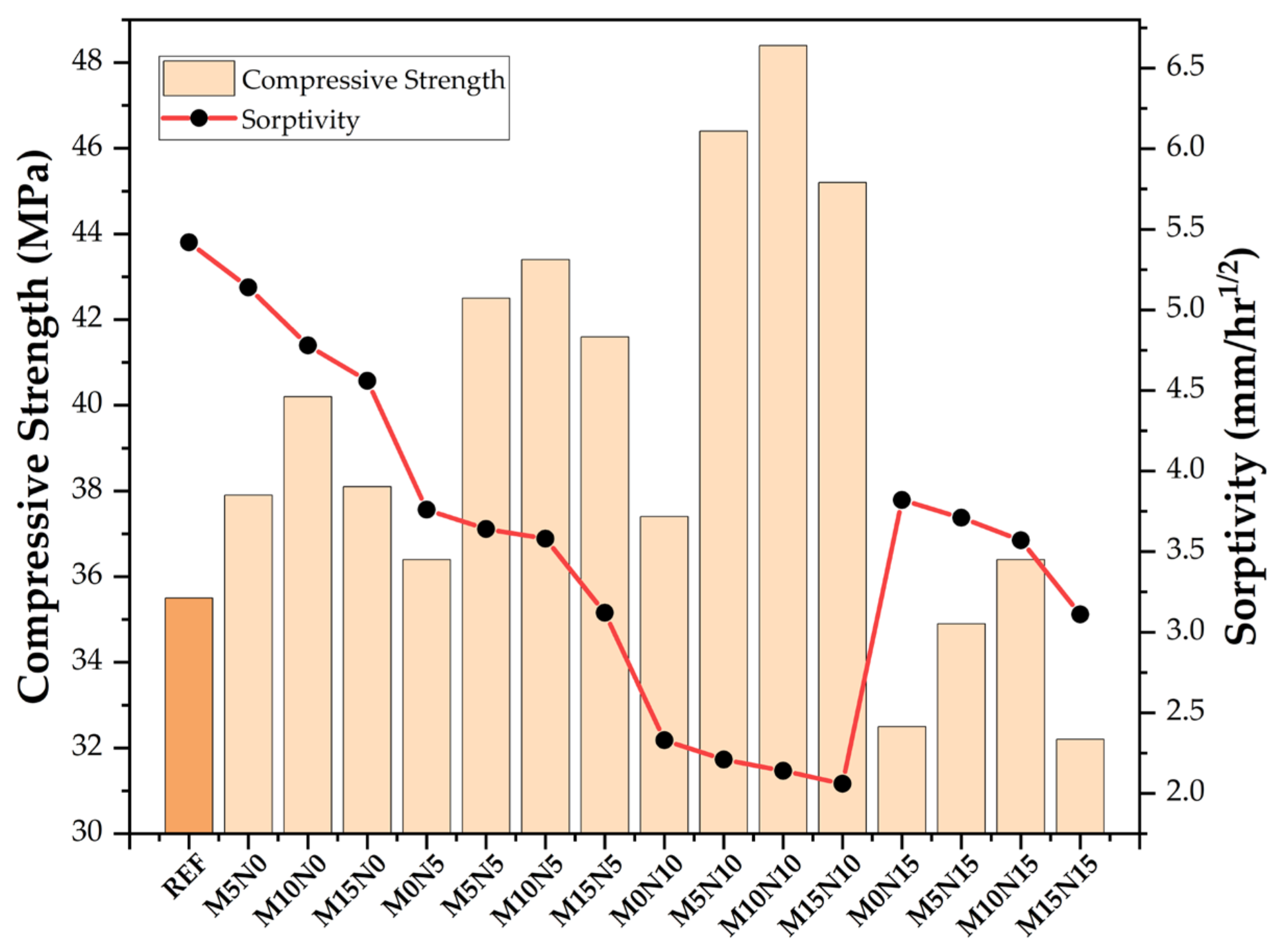
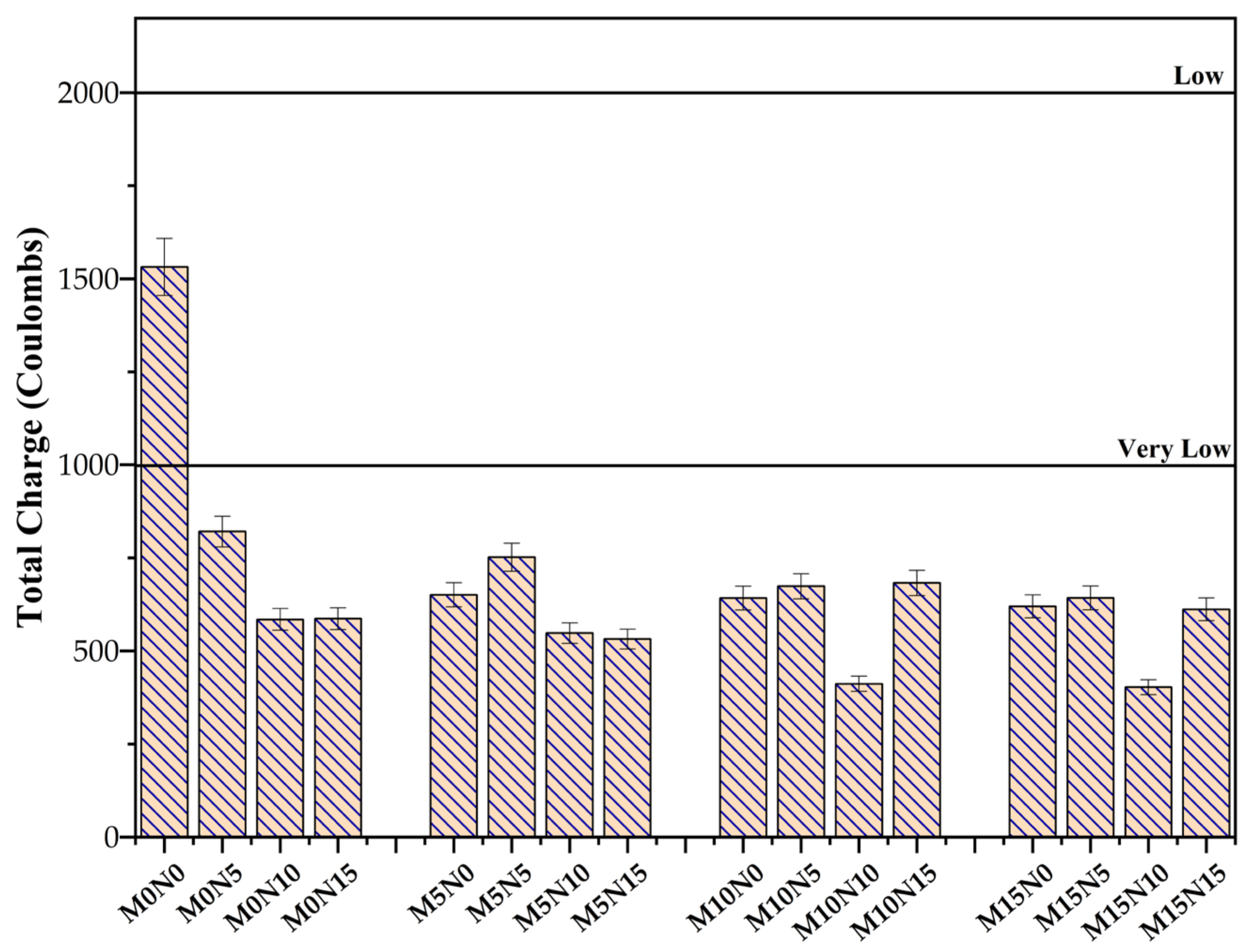
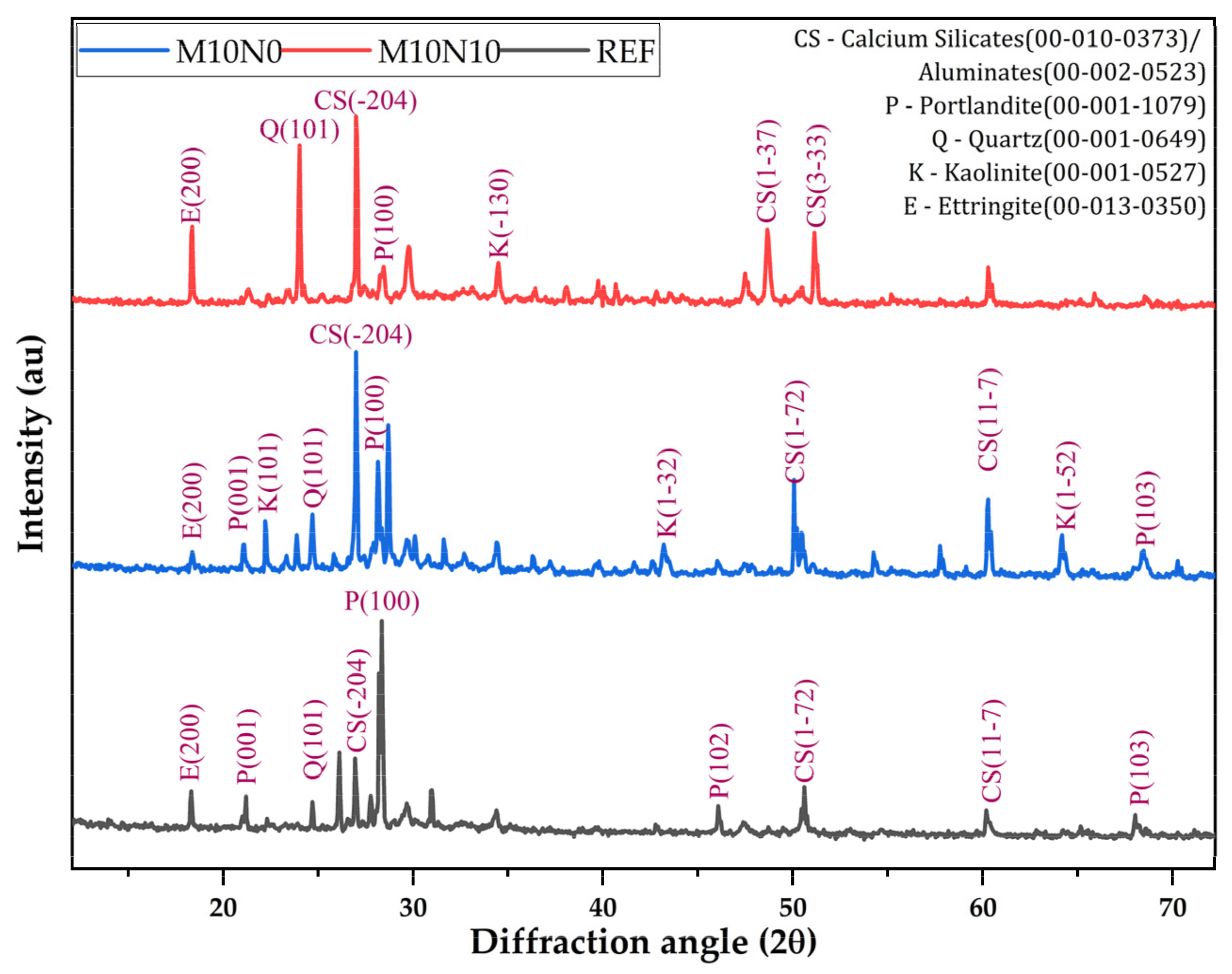

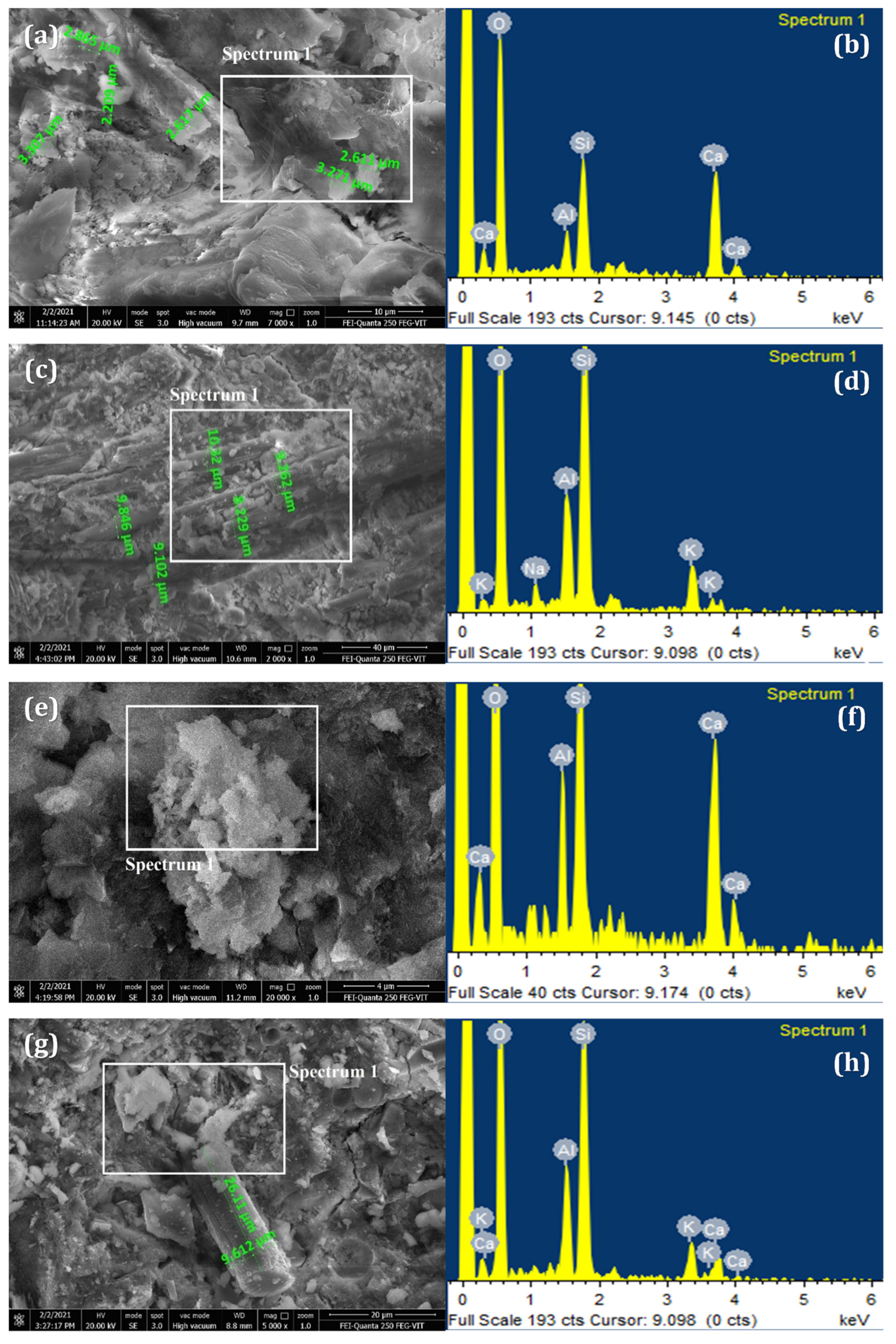
| Physical Property | Indian Standard | OPC 53 Grade |
|---|---|---|
| Consistency | IS 4031-4 (1998) | 35% |
| Initial setting | IS 4031-5 (1998) | 41 min |
| Final setting | IS 4031-5 (1998) | 605 min |
| Soundness | IS 4031-3 (1998) | 1.2 mm |
| Specific gravity | IS 4031-11 (1998) | 3.14 |
| Material/Oxide | CaO | MgO | SiO2 | Fe2O3 | Al2O3 | K2O | Na2O | LOI |
|---|---|---|---|---|---|---|---|---|
| OPC | 64.50 | 2.40 | 20.80 | 3.35 | 5.60 | 0.51 | 0.12 | 2.72 |
| Metakaolin | 0.11 | 0.02 | 51.50 | 0.58 | 45.20 | 0.91 | 0.10 | 1.58 |
| NMP | 24.9 | 0.57 | 52.2 | 0.98 | 18.96 | 0.65 | 0.35 | 1.39 |
| Physical Property | Natural Sand | Non-Metallic Powder | Coarse Aggregate |
|---|---|---|---|
| Fineness modulus | 2.68 | 2.89 | 7.52 |
| Specific gravity | 2.64 | 1.85 | 2.77 |
| Water absorption (%) | 1.36 | 2.91 | 0.60 |
| Bulk density (kg/m3) | 1723 | 882 | 1820 |
| Specimen Code | Mix Proportions (kg/m3) | ||||||
|---|---|---|---|---|---|---|---|
| Cement | MK | Fine Aggregate | NMP | Coarse Aggregate | Water | SP | |
| REF | 351 | 0 | 826 | 0 | 1114 | 158 | 4.212 |
| M5N0 | 333.45 | 17.55 | 826 | 0 | 1114 | 158 | 4.212 |
| M10N0 | 315.9 | 35.1 | 826 | 0 | 1114 | 158 | 4.212 |
| M15N0 | 298.35 | 52.65 | 826 | 0 | 1114 | 158 | 4.212 |
| M0N5 | 351 | 0 | 784.7 | 41.3 | 1114 | 158 | 4.212 |
| M5N5 | 333.45 | 17.55 | 784.7 | 41.3 | 1114 | 158 | 4.212 |
| M10N5 | 315.9 | 35.1 | 784.7 | 41.3 | 1114 | 158 | 4.212 |
| M15N5 | 298.35 | 52.65 | 784.7 | 41.3 | 1114 | 158 | 4.212 |
| M0N10 | 351 | 0 | 743.4 | 82.6 | 1114 | 158 | 4.212 |
| M5N10 | 333.45 | 17.55 | 743.4 | 82.6 | 1114 | 158 | 4.212 |
| M10N10 | 315.9 | 35.1 | 743.4 | 82.6 | 1114 | 158 | 4.212 |
| M15N10 | 298.35 | 52.65 | 743.4 | 82.6 | 1114 | 158 | 4.212 |
| M0N15 | 351 | 0 | 702.1 | 123.9 | 1114 | 158 | 4.212 |
| M5N15 | 333.45 | 17.55 | 702.1 | 123.9 | 1114 | 158 | 4.212 |
| M10N15 | 315.9 | 35.1 | 702.1 | 123.9 | 1114 | 158 | 4.212 |
| M15N15 | 298.35 | 52.65 | 702.1 | 123.9 | 1114 | 158 | 4.212 |
Publisher’s Note: MDPI stays neutral with regard to jurisdictional claims in published maps and institutional affiliations. |
© 2022 by the authors. Licensee MDPI, Basel, Switzerland. This article is an open access article distributed under the terms and conditions of the Creative Commons Attribution (CC BY) license (https://creativecommons.org/licenses/by/4.0/).
Share and Cite
Selvaraj, T.; T, S.; Kaliyavaradhan, S.K.; Kakria, K.; Malladi, R.C. Use of E-Waste in Metakaolin Blended Cement Concrete for Sustainable Construction. Sustainability 2022, 14, 16661. https://doi.org/10.3390/su142416661
Selvaraj T, T S, Kaliyavaradhan SK, Kakria K, Malladi RC. Use of E-Waste in Metakaolin Blended Cement Concrete for Sustainable Construction. Sustainability. 2022; 14(24):16661. https://doi.org/10.3390/su142416661
Chicago/Turabian StyleSelvaraj, Thirumalini, Shanmugapriya T, Senthil Kumar Kaliyavaradhan, Kunal Kakria, and Ravi Chandra Malladi. 2022. "Use of E-Waste in Metakaolin Blended Cement Concrete for Sustainable Construction" Sustainability 14, no. 24: 16661. https://doi.org/10.3390/su142416661
APA StyleSelvaraj, T., T, S., Kaliyavaradhan, S. K., Kakria, K., & Malladi, R. C. (2022). Use of E-Waste in Metakaolin Blended Cement Concrete for Sustainable Construction. Sustainability, 14(24), 16661. https://doi.org/10.3390/su142416661








